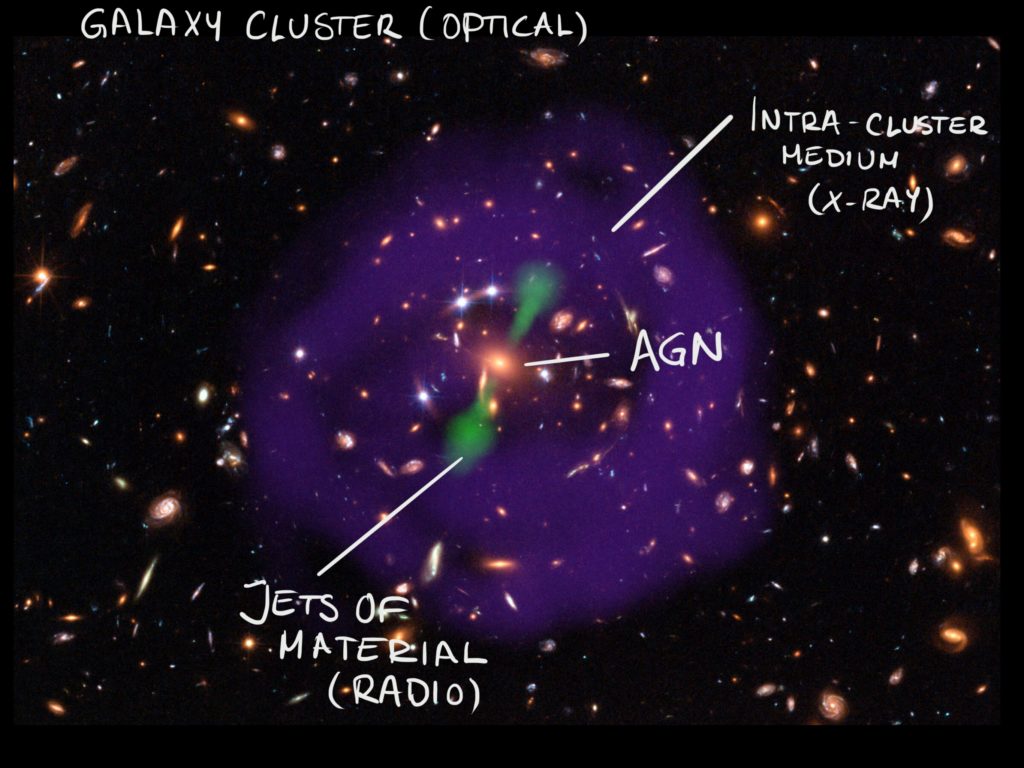A group of international researchers from South Africa, Germany, the United States of America, Finland, the United Kingdom, Italy and Australia have studied the relation between the X-ray emission of intra-group medium, the gas found between galaxies in a group, and the 1.4 GHz radio emission of the central radio galaxy of a group. This study forms part of the MeerKAT International GHz Tiered Extragalactic Exploration (MIGHTEE) project – a MeerKAT Large Survey Project to create deep images of the extragalactic sky to explore the cosmic evolution of galaxies.
The MIGHTEE project, a radio continuum survey, is one of the MeerKAT large survey projects supported by IDIA and designed to pathfind SKA key science in cosmology and galaxy evolution and has more than 140 international collaborators. The survey project seeks to answer questions such as: How are black holes fueled and how does accretion onto black holes affect the evolution of galaxies? How do we go from gas to stars in galaxies? How and when were the first galaxies formed? How do magnetic fields influence galaxy structure and growth? What is the environmental influence?
This particular study sought to investigate the relationship between the X-ray emission from the intra-group medium and the radio emission from the group’s central radio galaxy.
The correlation between these two sources of different light indicates that there is a physical relationship between what happens in the intra-group or intra-cluster medium, observed in X-rays, and the central galaxy, observed at radio wavelengths. Galaxy clusters are more strongly bound by gravity than galaxy groups. In galaxy clusters and in groups, there is a central galaxy with an active centre, known as an Active Galactic Nucleus (AGN). This AGN ejects matter into the intra-cluster medium, a process known as feedback.The impact of AGN feedback on the intergalactic medium is better studied in clusters than in groups, so the team decided to look at groups of galaxies.

The study involved the use of very deep Very Large Array and new MeerKAT observations from the MIGHTEE survey to compile a sample of about 250 galaxy groups with known X-ray emission from the intra-group medium. All the groups studied are in a patch of sky known as the COSMOS field. Through the use of statistical tests and Monte-Carlo simulations, researchers compared the groups with a sample of galaxy clusters and explored the correlation between the X-ray and the radio emissions.
The study found that the feedback processes that operate in galaxy clusters are also effective in groups.
The researchers found that mergers between galaxy clusters and the resulting changes to central cooling times, as well as changes in the accretion, can increase the scatter in the observed correlation.
This study concluded that clusters and groups follow a similar correlation once the dynamical state is taken into account.
The study also found that galaxy groups are more likely than clusters to host large radio galaxies and the researchers proposed reasons as to why that might be. To be continued…
Reference Article:
T. Pasini, M. Brūggen, F. de Gasperin, L. Bîrzan, E. O’Sullivan, A. Finoguenov, M. Jarvis, M. Gitti, F. Brighenti, I.H. Whittam, J.D. Collier, I. Heywood, G. Gozaliasl, 2020 MNRAS.
This paper will be published in the Monthly Notices of the Royal Astronomical Society, a peer reviewed journal. The MIGHTEE data was processed on the IDIA/ilifu cloud computing facility and Dr. J. D. Collier, one of the authors, is an IDIA staff member.
